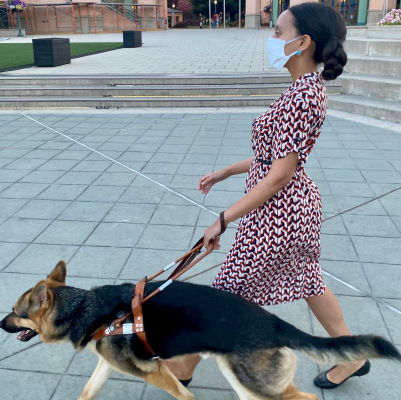The robot, shaped like a large cooler on wheels, zipped along somewhere ahead of me. My left hand clasped the smooth leather harness of my German shepherd guide dog. “Mylo, forward.” The speed of his four short legs complemented the strides of my longer two — call it the six feet fox trot. Together we glided past the competition.
My quarantine buddy stayed behind filming the race. Mylo: 1, Robot: 0.
The Mountain View City Council voted on May 5, 2020 to allow Starship Technologies’ robots on city streets. Founded in 2014, Starship operates no-contact delivery robots in several cities around the world. Customers schedule deliveries of food, groceries or other packages through the Starship app.
My amusement with the little robots shifted to curiosity. Thirty years after the Americans with Disabilities Act of 1990, many tech companies still fail to design for disability. How would the autonomous robots react to disabled pedestrians?
About 10 feet down the sidewalk, I stopped and turned around. Mylo tensed, his alarm crawling up my arm. The white visage of the robot stopped about a foot from his nose.
I hoped the robot would identify a pedestrian and roll away, but it stayed put. Mylo relaxed into a sitting position — guide dog school didn’t teach him about the robot apocalypse. I scratched his ears and he leaned into my hands. The robot was not moved.
More than 61 million people in the U.S. have disabilities, a significant number of whom use wheelchairs, scooters, walkers and other mobility devices. Emily Ackerman, a power wheelchair user and University of Pittsburgh Ph.D. student, encountered a Starship robot while crossing a busy four-lane street; she needed the curb cut it occupied. “I managed to squeeze myself up on the sidewalk in a panic, climbing the curb outside the curb cut in fear of staying in the street any longer — a move that causes a painful jolt and could leave me stuck halfway up if I’m not careful,” wrote Ackerman in a 2019 article.
In the ’60s and ’70s disabled activists protested the lack of accessible sidewalks, then later wielded the ADA to compel cities across the country to install curb cuts and repair broken sidewalks. Wheelchair users, parents pushing strollers, kids with skateboards and now even robots benefit from these hard-won curb cuts. Disability-driven designs improve experiences for the whole community.
My standoff with the robot occurred six months after Ackerman’s article calling out Starship for failing disabled pedestrians. I waited patiently for it to back up, but the rascal remained rooted to the spot. As a deaf-blind person with full mobility, I had the ability to maneuver around the robot. With heavy steps I walked past it, continuing my daily physical distancing walk.
Before the pandemic, Mylo would accompany me to foreign countries, book talks and social dances. Dancing swing and salsa I could sense the beat through my dance partners’ hands and shoulders. Remembering those nights plunges me into nostalgia. So many of my interactions rely on my sharpened tactile intelligence. Our current no-touch world isolates me more than deaf-blindness ever could.
My home centers around touch-based solutions. The tactile stickers I added to my microwave and washing machine allow me to operate them on my own. The coffee machine, blender and stove all have physical controls. Even my phone supports tactile access. VoiceOver on the iPhone reads content out loud, sends dots popping on a connected braille computer and allows for nonvisual touchscreen navigation through gestures. I read the news, conduct research and schedule deliveries on websites and apps compatible with VoiceOver.
Relying on the internet as my primary channel to the outside world constantly throws me against barriers. Many web and app developers ignore accessibility guidelines and the ADA. News feeds are full of images without descriptions, videos without captions or transcripts, and recommendations for new apps to help everyone. In my experience, the word “everyone” means everyone except disabled people.
Thinking the no-contact delivery robots could benefit blind people, I tested the app with VoiceOver on the iPhone. The Starship app refused to fly with VoiceOver, crashing my hopes for a no-contact solution.
During a pandemic disproportionately extinguishing disabled lives, the last thing we need is cities adopting tech that excludes blind people and endangers pedestrians with mobility disabilities. The ADA’s promise of equality depends on enforcement. Advocates have already applied the ADA to Netflix’s video streaming, Scribd’s digital library, Domino’s online ordering and other tech services.
Cities and tech companies need to plan for accessibility early in the design process, include disabled people in solutions and review the many published accessibility guidelines. The next time Mylo and I encounter a robot, it better jump, spin and run.
[ad_2]
Source link


